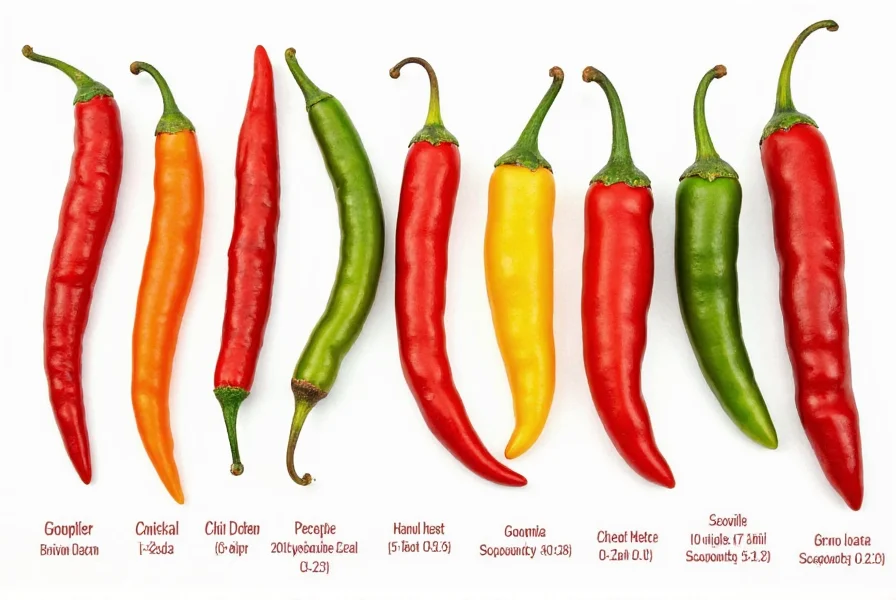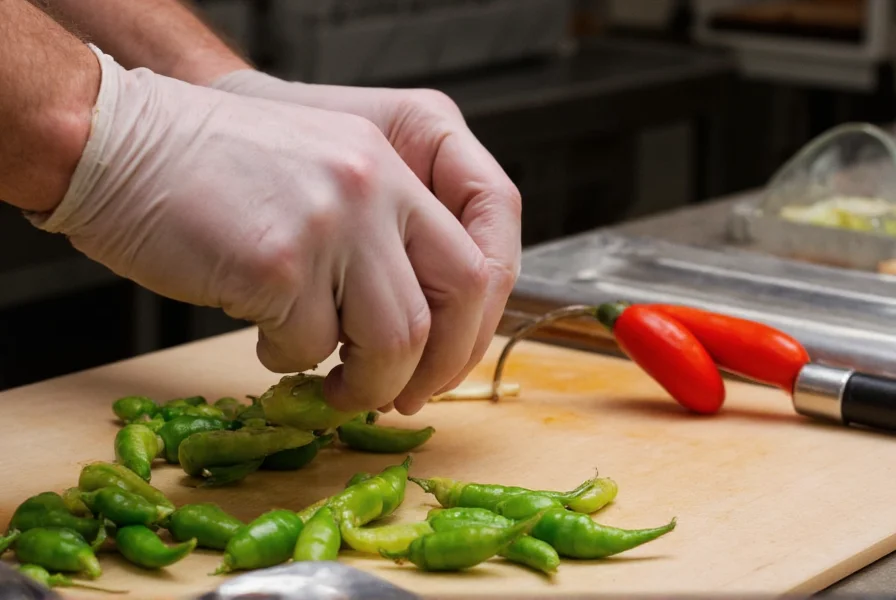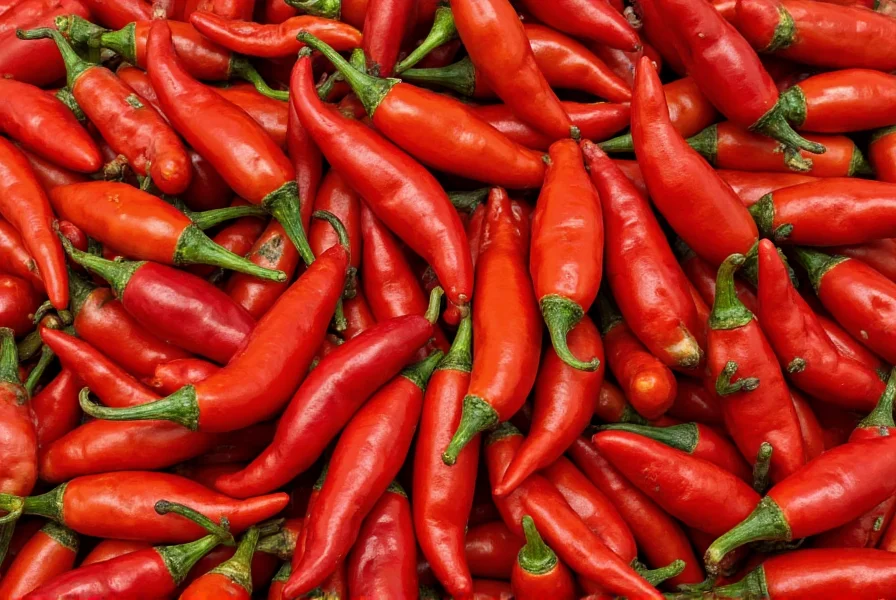Understanding chili heat levels is essential for both novice cooks and professional chefs. The Scoville scale, developed by pharmacist Wilbur Scoville in 1912, measures the concentration of capsaicin—the compound responsible for chili pepper heat—in Scoville Heat Units (SHU). Modern testing uses high-performance liquid chromatography for precise measurements, but the Scoville scale remains the standard reference for comparing chili pepper heat levels.
How the Scoville Scale Works
The Scoville scale measures heat intensity by determining how much sugar-water solution is needed to dilute the capsaicin in a pepper until the heat is no longer detectable. A bell pepper registers 0 SHU because it contains no capsaicin, while the Trinidad Moruga Scorpion can reach up to 2 million SHU. This logarithmic scale means each step represents a tenfold increase in heat intensity.
Comprehensive Chili Pepper Heat Chart
| Chili Pepper Variety | Scoville Heat Units (SHU) | Common Uses | Flavor Profile |
|---|---|---|---|
| Bell Pepper | 0 SHU | Salads, stuffed peppers, stir-fries | Sweet, vegetal |
| Pepperoncini | 100-500 SHU | Pickled vegetables, Greek salads | Mildly tangy, slightly bitter |
| Jalapeño | 2,500-8,000 SHU | Salsa, nachos, poppers | Grassy, bright heat |
| Serrano | 10,000-23,000 SHU | Pico de gallo, hot sauces | Sharp, clean heat |
| Habanero | 100,000-350,000 SHU | Caribbean dishes, hot sauces | Fruity, floral with intense heat |
| Ghost Pepper (Bhut Jolokia) | 800,000-1,041,427 SHU | Extreme hot sauces, challenges | Smoky, sweet before intense burn |
| Carolina Reaper | 1,400,000-2,200,000 SHU | Specialty hot sauces | Fruity start with delayed extreme heat |
Practical Applications of Chili Charts
Professional kitchens and home cooks rely on chili charts when developing recipes that require precise heat levels. When substituting one pepper for another, understanding the Scoville scale prevents dishes from becoming unexpectedly mild or unbearably hot. For example, replacing jalapeños with habaneros in a 1:1 ratio would increase the heat by approximately 20 times.
Food manufacturers use chili charts to standardize product heat levels, ensuring consistency across batches of hot sauces, salsas, and spice blends. This standardization helps consumers make informed choices based on their personal heat tolerance.

Factors Affecting Perceived Heat
Several variables influence how heat is perceived beyond the Scoville rating:
- Individual tolerance: Regular chili consumers develop higher tolerance over time
- Ripeness: Riper peppers generally contain more capsaicin
- Growing conditions: Soil, climate, and water stress affect heat levels
- Preparation method: Removing seeds and membranes reduces heat significantly
- Food pairing: Dairy products neutralize capsaicin, while alcohol can intensify the burn
Safety Considerations When Handling Hot Peppers
Working with extremely hot peppers requires precautions. Always wear gloves when handling peppers above 50,000 SHU, and avoid touching your face. If capsaicin contacts skin, wash with soap and cool water—avoid hot water which opens pores. For eye exposure, flush with milk or specialized pepper spray wipes rather than water.
When cooking with super-hot peppers, start with minuscule amounts. A single Carolina Reaper seed contains enough capsaicin to noticeably heat an entire pot of chili. Never inhale fumes from cooking extremely hot peppers, as this can cause respiratory distress.

Regional Variations in Chili Preferences
Culinary traditions around the world have developed distinctive approaches to chili heat. Thai cuisine frequently uses bird's eye chilies (50,000-100,000 SHU) for their bright, sharp heat. Mexican cooking often features jalapeños and serranos for balanced heat in salsas. Indian cuisine incorporates a wide range from mild Kashmiri chilies to extremely hot bhut jolokias in regional specialties.
Understanding these regional preferences helps when adapting recipes. A "mild" Indian curry might still contain 15,000 SHU chilies that would be considered quite hot in American cuisine. The global popularity of chili peppers has created fusion cuisines that blend heat levels from different traditions.
Creating Your Own Custom Chili Chart
For serious chili enthusiasts, creating a personalized heat reference can be valuable. Start by tasting small amounts of different peppers with dairy on hand for relief. Rate each pepper on a 1-10 scale based on your personal tolerance. Note the time it takes for the heat to register and how long it lasts. This customized chili heat measurement guide will serve you better than generic charts when developing recipes tailored to your palate.
FAQ
What is the most reliable way to measure chili pepper heat?
The most reliable method for measuring chili heat is high-performance liquid chromatography (HPLC), which precisely measures capsaicinoid concentration. This scientific approach has largely replaced the original Scoville organoleptic test, which relied on human taste testers. HPLC results are then converted to Scoville Heat Units for consumer understanding.
Can cooking methods change a chili pepper's heat level?
Yes, cooking methods significantly affect perceived heat. Roasting can mellow a pepper's heat while enhancing its sweetness. Drying chilies concentrates capsaicin, making them hotter by weight. Fermentation, as in hot sauce production, can modify heat perception by breaking down some capsaicin compounds while developing complex flavors. Adding acidic ingredients can also intensify heat perception.
Why do some people enjoy extremely hot peppers despite the pain?
The enjoyment of extremely hot peppers relates to the body's natural response to capsaicin. When capsaicin triggers pain receptors, the brain releases endorphins—natural painkillers that create a sense of pleasure or euphoria. Regular chili eaters often develop both higher tolerance and appreciation for this endorphin response, sometimes described as a "chili high." Cultural factors and social aspects of chili challenges also contribute to this phenomenon.
How can I reduce the heat of a dish that's too spicy?
To reduce excessive heat in a dish, add dairy products like yogurt, sour cream, or milk, which contain casein that binds to capsaicin. Acidic ingredients like lime juice or vinegar can help balance heat perception. Sweeteners such as sugar or honey counteract spiciness through flavor contrast. Increasing the overall volume of the dish with additional non-spicy ingredients also dilutes the heat. Never use water, as it spreads capsaicin rather than neutralizing it.











 浙公网安备
33010002000092号
浙公网安备
33010002000092号 浙B2-20120091-4
浙B2-20120091-4